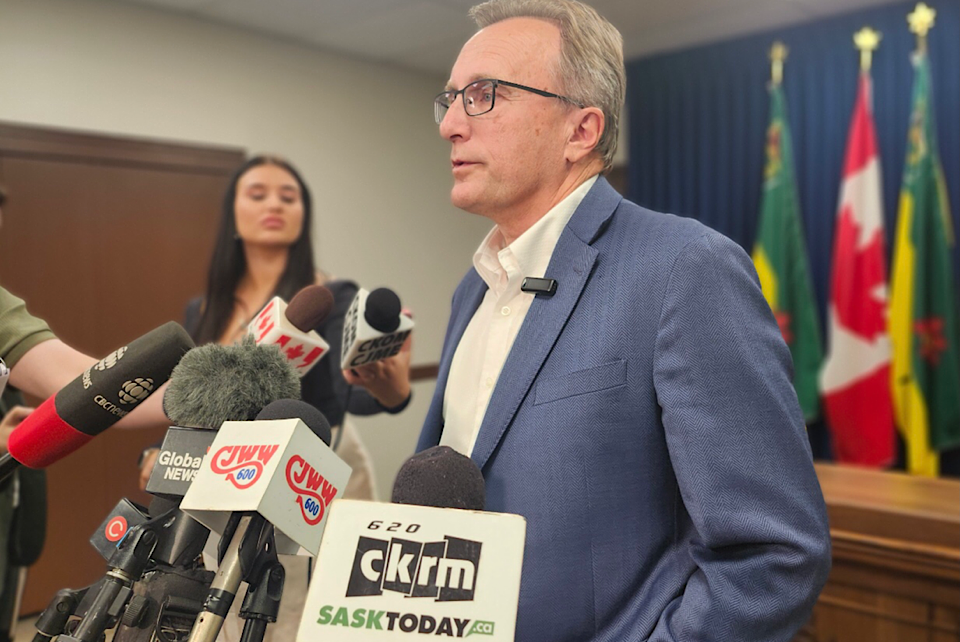SASKATOON — Saskatchewan’s $12 million surplus at budget time has transformed into a $349 million deficit as of the first quarter.
That is the main story to emerge from the first quarter update presented by Finance Minister Jim Reiter in Saskatoon.
According to this update, the total revenue is forecast to be $20.9 billion and the expense is forecast to be $21.2 billion.
“So percentage-wise it's not huge, but it's still a significant amount of money,” said Reiter, who nevertheless expressed confidence the finances were still in good shape.
“We're always concerned. Our fundamentals are still strong. We've got the best credit rating in the country. We've got the second best net debt to GDP in the country. We're going to keep an eye on coffers, but we're also going to respond when the people of Saskatchewan need it.”
Here is what to know about Saskatchewan’s budget dipping into the red in the quarterly update.
Total revenue is lower, mainly due to SaskPower decrease
Total revenue is forecast to be $172 million lower compared to budget, with the drop largely due to a dip in Government Business Enterprise net income, including a $163 million decrease in SaskPower net income due to removal of the federal carbon tax from customer bills in the first quarter. They had budgeted $126.3 million in net income for SaskPower, but the change turned that number into a $36.9 million loss.
Non-renewable resources revenue is also expected to drop $29.5 million compared to budget, with lower oil prices and a higher exchange rate being cited.
The province says it will continue to engage in discussions with the federal government to remove industrial carbon pricing from the electricity sector.
“We're continuing to have discussions,” said Reiter. “I know the Premier has, I have with a number of ministers discussions on where we go with the asking the federal government to reverse course on that. In the meantime though, this acts as an affordability measure. SaskPower is absorbing that cost so that people with Saskatchewan residents, homeowners, businesses will have to pay that.”
Total expense is higher, with wildfires a factor
Total expenses are forecast to be $189 million higher than budget. This is primarily the result of an $80 million increase to address wildfire activities.
The expense is included in the first quarter report forecasts and will be addressed in a special warrant to be released on Aug. 25.
There is also a $115 million increase in expenses associated with year-end updates to pension accrual assumptions.
Reiter spoke about both expense increases to reporters.
“Well, certainly I think this was probably the worst wildfire season in history,” Reiter said. “But there was planning done. Not this previous budget, the budget before — four new water bombers were ordered. They're coming at staggered delivery dates.
“The actuarial studies by the pension plans, those are difficult to predict until the actuaries do their work. Those can go up or down. You see the breakdown in the report you were given where that comes from.
“Obviously, again, I would just say we're concerned about it. We're going to keep a lid on expenses. But overall, we're probably in the best financial situation of any province in the country.”
Impact of tariffs
There had been much discussion about whether or not Saskatchewan ought to have included a contingency to address the tariff situation in the budget.
No contingency was included in the end, with Reiter justifying the decision at the time by pointing to the difficulty in predicting the impact.
As for the first quarter update, Reiter told reporters that tariffs “haven't had a big impact so far in the first quarter.”
But Reiter did say the government was “very concerned” because there is “impact in a lot of areas.” He pointed to canola tariffs with the Chinese, as well as the U.S.A. broadening the number of products that are being hit by tariffs under steel.
Reiter also spoke of an announcement that morning by Prime Minister Mark Carney that Canada would take off counter tariffs against the USA on CUSMA products.
“That's all just flushing out right now. So that's the problem with trying to predict these things. You can see, I think today's a perfect example. How do you predict that when it's changing literally by the hour? So the best way we think, which is what we said in the spring at budget time, (the) best thing we can do is have our fiscal house in order, be in a strong economic position, which we are, and see what happens, do the best we can with advocating with the federal government and our other trading partners.”
Reiter points to strength of Saskatchewan economy
The government continued to point to strength in Saskatchewan's economy in the first half of 2025. In a news release they pointed to major private sector projects and housing construction, retail sales and labour market performance as still among the strongest in Canada. They also point to Saskatchewan maintaining the highest credit rating among the provinces, and a net debt-to-GDP ratio projected to be 14.5 per cent as of March 31, 2026, which they say is an improvement over budget projections and the second-lowest among the provinces.
“Certainly ... we'd much rather have a surplus,” Reiter told reporters. “It's an indicator of expense versus revenue. I think it's important to put it in perspective though with all the other economic indicators. As I said, we're at or near the top compared to every other province in the country, but taking it very seriously…
“We're about to go into (the) budget process. We're going to sharpen our pencils and look for places to save money. But at the same time, we're not going to do it at the expense of health care, education, or the other services that people in Saskatchewan expect.”
With files from Jon Perez




